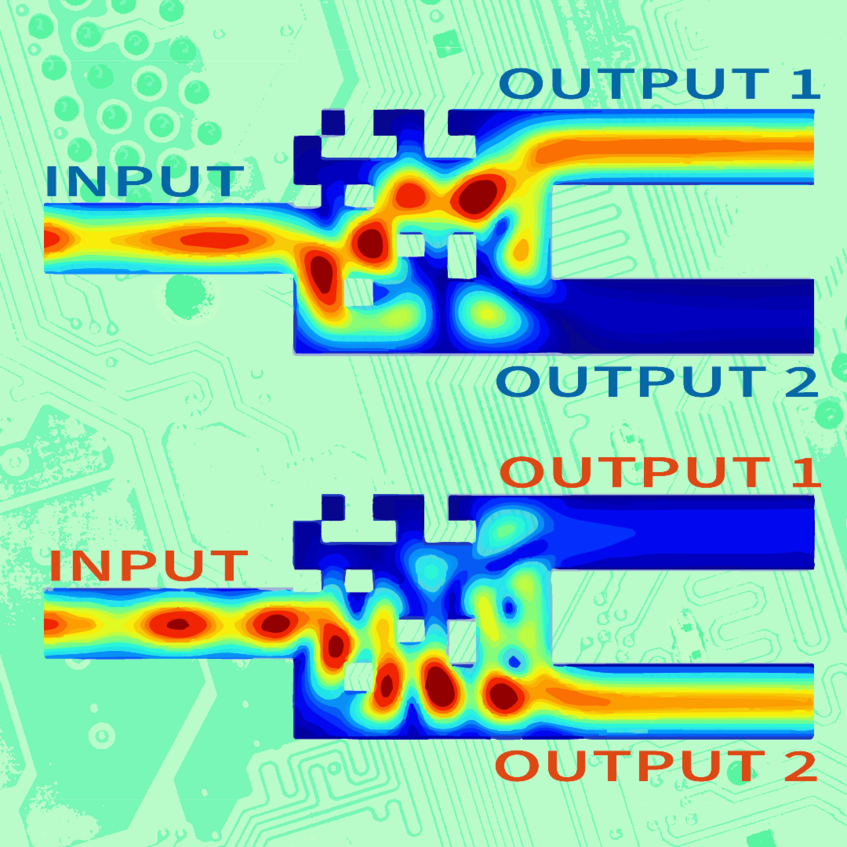Machine-learning inverse-design magnonics
Principal Investigator: Univ.-Prof. Dr. Andrii Chumak
Scientific Project Staff: Fabian Majcen (PhD student), Noura Zenbaa (PhD student), Andrey Voronov (PhD student), Boris Valenta (master's student)
Partners:
Physics of Functional Materials, Faculty of Physics, University of Vienna
Team: Prof. Dr. Dieter Suess, PD Dr. Claas Abert, Dr. Florian Bruckner
University for Continuing Education Krems
Team: Univ.-Doz. Dipl.-Ing. Dr. Thomas Schref
School of Physics, Huazhong University of Science and Technology
Team: Prof. Dr. Qi Wang

In recent years, the area of magnonics has seen an enhancement with various creative devices, made possible through devoted skill and detailed investigation. The implementation of machine learning and inverse design, well-established in photonics and the creation of big-scale integrated CMOS circuits, has now been extended into magnonics. This exciting blend opens up new opportunities for magnonic technology. It is ready for a fast and transformative ascent with advanced computational design methods. The powerful impact of artificial intelligence, which is quickly changing our daily lives, also has great potential to advance the field of magnonics.
The inverse-design approach elegantly prioritizes the definition of desired outcomes, leveraging feedback-driven computational algorithms, such as those found in machine learning, to architect devices that fulfill these specified functions. Emblematic of its versatility, two parallel publications have heralded the success of inverse design in magnonics. Illustrating the method's broad applicability, an array of magnonic features—linear, nonlinear, and nonreciprocal—were explored as documented in [Nature Commun. 12, 2636 (2021)], employing the technique to invent a magnonic (de)multiplexer, a nonlinear switch, and a Y-circulator. This was embodied in a three-port prototype, ingeniously crafted from a ferromagnetic rectangle structured by square voids, guided by a direct binary search algorithm. Furthermore, in [Nature Commun. 12, 6422 (2021)], researchers embraced a higher tier of complexity, inverse-designing a neural network manifested as a YIG domain with a precise arrangement of nanomagnets. This demonstrated that neuromorphic computing tasks, including the intricate signal routing required for nonlinear activations, can be adeptly executed through the manipulation of spin-wave travel and interference—with the intricate task of vowel recognition showcasing the prowess of the inverse-designed magnonic neural network.
An alternate variation of the inverse design paradigm was recently employed to craft linear spin-wave pulses with tailored spatial-temporal characteristics within magnonic waveguides, as explained in [Phys. Rev. Applied 19, 064085 (2023)]. This innovative approach tackles a prominent challenge in the quest for fast magnonic information-processing devices: the imperative to manage short spin-wave pulses, which, while desirable for speed, are susceptible to information degradation through broadening and dispersion. The deft application of inverse engineering to fine-tune these spin-wave pulses and master their propagation has emerged as a solution to this problem.
The benefits of inverse design are numerous and significant:
- Its universality is unmatched—it serves as an invaluable instrument across a spectrum of applications from RF to binary and neuromorphic computing, and for the meticulous design and fine-tuning of components within any magnonic network.
- It harbors the unique potential to amalgamate diverse functionalities within a singular device—for instance, an RF multiplexer seamlessly integrated with a Y-circulator and a power limiter.
- The level of functional complexity it can achieve is only bounded by the parameter matrix's dimensions and the number of states per matrix element—enabling, for example, a single, compact chip with an intricate matrix to perform as a full adder, rather than resorting to the traditional method of chaining two half adders.
- It naturally extends to the engineering of neuromorphic circuits, adeptly handling intricate computational tasks with finesse.
Project publications
Submitted articles
- Perspective on Nanoscaled Magnonic Networks
Q. Wang, G. Csaba, R. Verba, A. V. Chumak, P. Pirro
arXiv:2311.06129
Published articles
- Generation of Spin-Wave Pulses by Inverse Design
S. Casulleras, S. Knauer, Q. Wang, O. Romero-Isart, A. V. Chumak, C. Gonzalez-Ballestero,
Phys. Rev. Applied 19, 064085 (2023) - Inverse-design magnonic devices
Q. Wang, A.V. Chumak, P. Pirro
Nat. Commun. 12, 2636 (2021)
